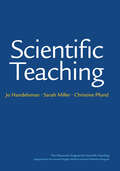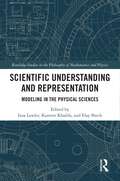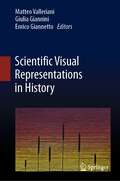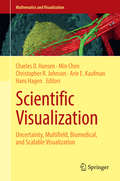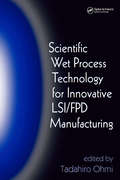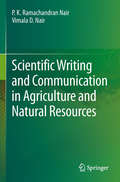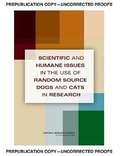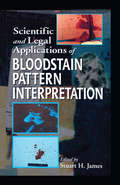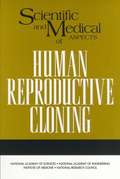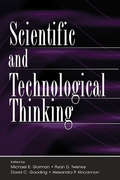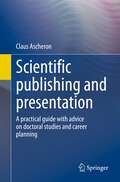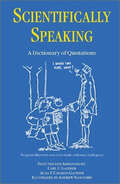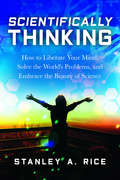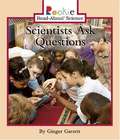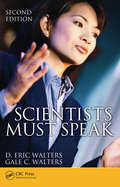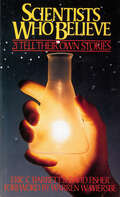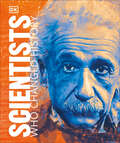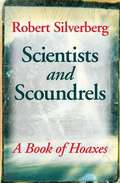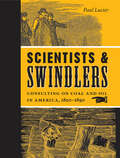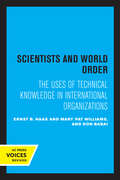- Table View
- List View
Scientific Teaching
by Sarah Miller Jo Handelsman Christine PfundSeasoned classroom veterans, pre-tenured faculty, and neophyte teaching assistants alike will find this book invaluable. <p><p> HHMI Professor Jo Handelsman and her colleagues at the Wisconsin Program for Scientific Teaching (WPST) have distilled key findings from education, learning, and cognitive psychology and translated them into six chapters of digestible research points and practical classroom examples. The recommendations have been tried and tested in the National Academies Summer Institute on Undergraduate Education in Biology and through the WPST. Scientific Teaching is not a prescription for better teaching. Rather, it encourages the reader to approach teaching in a way that captures the spirit and rigor of scientific research and to contribute to transforming how students learn science.
Scientific Understanding and Representation: Modeling in the Physical Sciences (Routledge Studies in the Philosophy of Mathematics and Physics)
by Kareem Khalifa Insa Lawler Elay ShechThis volume assembles cutting-edge scholarship on scientific understanding, scientific representation, and their delicate interplay. Featuring several articles in an engaging ‘critical conversation’ format, the volume integrates discussions about understanding and representation with perennial issues in the philosophy of science, including the nature of scientific knowledge, idealizations, scientific realism, scientific inference, and scientific progress.In the philosophy of science, questions of scientific understanding and scientific representation have only recently been put in dialogue with each other. The chapters advance these discussions from a variety of fresh perspectives. They range from case studies in physics, chemistry, and neuroscience to the representational challenges of machine learning models; from special forms of representation such as maps and topological models to the relation between understanding and explanation; and from the role of idealized representations to the role of representation and understanding in scientific progress.Scientific Understanding and Representation will appeal to scholars and advanced students working in philosophy of science, philosophy of physics, philosophy of mathematics, and epistemology.
Scientific Visual Representations in History
by Matteo Valleriani Enrico Giannetto Giulia GianniniThis book explores continuity and ruptures in the historical use of visual representations in science and related disciplines such as art history and anthropology. The book also considers more recent developments that attest to the unprecedented importance of scientific visualizations, such as video recordings, animations, simulations, graphs, and enhanced realities. The volume collects historical reflections concerned with the use of visual material, visualization, and vision in science from a historical perspective, ranging across multiple cultures from antiquity until present day. The focus is on visual representations such as drawings, prints, tables, mathematical symbols, photos, data visualizations, mapping processes, and (on a meta-level) visualizations of data extracted from historical sources to visually support the historical research itself. Continuity and ruptures between the past and present use of visual material are presented against the backdrop of the epistemic functions of visual material in science. The function of visual material is defined according to three major epistemic categories: exploration, transformation, and transmission of knowledge.
Scientific Visualization
by Hans Hagen Min Chen Charles D. Hansen Christopher R. Johnson Arie E. KaufmanBased on the seminar that took place in Dagstuhl, Germany in June 2011, this contributed volume studies the four important topics within the scientific visualization field: uncertainty visualization, multifield visualization, biomedical visualization and scalable visualization. * Uncertainty visualization deals with uncertain data from simulations or sampled data, uncertainty due to the mathematical processes operating on the data, and uncertainty in the visual representation, * Multifield visualization addresses the need to depict multiple data at individual locations and the combination of multiple datasets, * Biomedical is a vast field with select subtopics addressed from scanning methodologies to structural applications to biological applications, * Scalability in scientific visualization is critical as data grows and computational devices range from hand-held mobile devices to exascale computational platforms. Scientific Visualization will be useful to practitioners of scientific visualization, students interested in both overview and advanced topics, and those interested in knowing more about the visualization process.
Scientific Wet Process Technology for Innovative LSI/FPD Manufacturing
by Tadahiro OhmiAs science pushes closer toward the atomic size scale, new challenges arise to slow the pace of the miniaturization that has transformed our society and fueled the information age. New technologies are necessary to surpass these obstacles and realize the tremendous growth predicted by Moore's law. Assembled from the works of pioneering researchers, Scientific Wet Process Technology for Innovative LSI/FPD Manufacturing presents new developments and technologies for producing the next generation of electronic circuits and displays.This book introduces radical-reaction-based semiconductor manufacturing technologies that overcome the limitations of the existing molecule-reaction-based technologies. It systematically details the procedures and underlying concepts involved in wet process technologies and applications. Following an introduction to semiconductor surface chemical electronics, expert contributors discuss the principles and technology of high-performance wet cleaning; etching technologies and processes; antistatic technology; wet vapor resist stripping technology; and process and safety technologies including waste reclamation, chemical composition control, and ultrapure water and liquid chemical supply systems and materials for fluctuation-free facilities.Currently, large production runs are needed to balance the costs of acquiring and tuning equipment for specialized operating conditions. Scientific Wet Process Technology for Innovative LSI/FPD Manufacturing explains the technologies and processes used to meet the demand for variety and low volumes that exists in today's digital electronics marketplace.
Scientific Writing and Communication in Agriculture and Natural Resources
by P.K. Ramachandran Nair Vimala D. NairThe purpose of this book is to help early career professionals in agriculture and natural resources write their research papers for high-quality journals and present their results properly at professional meetings. Different fields have different conventions for writing style such that the authors of the book have found it difficult to recommend to young scientists in these fields a specific book or source material out of the several that are available as the "go to" guide. Writing a scientific paper is a tedious task even to experienced writers; but it is particularly so for the early career professionals such as students, trainees, scientists and scholars in agriculture and natural resources; the challenge is even more when their first language of communication is not English. This book is targeted mainly to that group.
Scientific and Humane Issues in the Use of Random Source Dogs and Cats in Research
by National Research Council of the National AcademiesScientific and Humane Issues in the Use of Random-Source Dogs and Cats in Research examines the value of random-source animals in biomedical research and the role of Class B dealers who acquire and resell live dogs and cats to research institutions. Findings include that, while some random-source dogs and cats may be necessary and desirable for National Institutes of Health (NIH)-funded research, there is no clear need to obtain those animals from Class B dealers. Several options for random-source animal acquisition already exist and additional options are recommended, which would further ensure the welfare of these animals and foster a positive public image for NIH. While the scientific community has recognized and responded to concerns for humane treatment of animals in research, government oversight has thus far been unable to fully enforce the Animal Welfare Act in regard to Class B dealers of live animals. Although the animals acquired by Class B dealers are destined for research--and NIH research in particular--the standard of care while in the possession of some Class B dealers requires an inordinate amount of government enforcement and is not commensurate with the policies of most NIH-funded research laboratories. This dichotomy of standards reflects poorly on public perceptions of NIH and jeopardizes animal welfare. This book will be crucial for NIH and other groups using random-source animals in research, including veterinary schools and research facilities. Animal welfare advocates, policy makers, and concerned pet owners will also find this a vital and informative work for reconciling the needs of research with the welfare of animals.
Scientific and Legal Applications of Bloodstain Pattern Interpretation
by Stuart H. JamesSince 1955 when Dr. Paul Kirk first presented a bloodstain evidence affidavit in State of Ohio v. Samuel Sheppard, expert testimony on bloodstain interpretation has gained wide acceptance in U.S. courts. Scientific and Legal Applications of Bloodstain Pattern Interpretation brings together some of the most respected and noted experts in forensic science, the law, and bloodstain interpretation to provide a comprehensive overview of the discipline. It discusses research, applications, and the current view of bloodstain pattern interpretation within the legal system at the trial and appellate court levels, as well as scientific approaches and developments in the field.Scientific and Legal Applications of Bloodstain Pattern Interpretation will help attorneys who are questioning and cross-examining expert witnesses have a good working knowledge of bloodstain interpretation. Included is a full-color atlas of bloodstains, in conjunction with a glossary of terms and an outline of basic laboratory experiments that are commonly used in the discipline. Among the outstanding contributions in this volume you will find:An excellent chapter by Carol Henderson discusses the legal and ethical aspects of bloodstain pattern evidence in detail. A post-conviction analysis by Marie Elena Saccoccio evaluates how bloodstain evidence can play a role in the appeal process. Misinterpretation and overinterpretation of bloodstain evidence can occur in our courts of law-be prepared to effectively analyze the evidence and the testimony with Scientific and Legal Applications of Bloodstain Pattern Interpretation.
Scientific and Medical Aspects of Human Reproductive Cloning
by Committee on Science Engineering Public PolicyHuman reproductive cloning is an assisted reproductive technology that would be carried out with the goal of creating a newborn genetically identical to another human being. It is currently the subject of much debate around the world, involving a variety of ethical, religious, societal, scientific, and medical issues. Scientific and Medical Aspects of Human Reproductive Cloning considers the scientific and medical sides of this issue, plus ethical issues that pertain to human-subjects research. Based on experience with reproductive cloning in animals, the report concludes that human reproductive cloning would be dangerous for the woman, fetus, and newborn, and is likely to fail. The study panel did not address the issue of whether human reproductive cloning, even if it were found to be medically safe, would be—or would not be—acceptable to individuals or society.
Scientific and Technological Thinking
by Michael E. Gorman Ryan D. Tweney David C. Gooding Alexandra P. KincannonAt the turn of the 21st century, the most valuable commodity in society is knowledge--particularly new knowledge that may give a culture, company, or laboratory an adaptive advantage. Knowledge about the cognitive processes that lead to discovery and invention can enhance the probability of making valuable new discoveries and inventions. Such knowledge needs to be made widely available to ensure that no particular interest group "corners the market" on techno-scientific creativity. Knowledge can also facilitate the development of business strategies and social policies based on a genuine understanding of the creative process. Furthermore, through an understanding of principles underlying the cognitive processes related to discovery, educators can utilize these principles to teach students effective problem-solving strategies as part of their education as future scientists.This book takes the reader out onto the cutting edge of research in scientific and technological thinking. The editors advocate a multiple-method approach; chapters include detailed case studies of contemporary and historical practices, experiments, computational simulations, and innovative theoretical analyses. The editors attempt a provocative synthesis of this work at the end.In order to achieve true scientific and technological progress, an understanding of the process by which species are transforming the world is needed. This book makes an important step in that direction by leading to breakthroughs in the understanding of discovery and invention.
Scientific publishing and presentation: A practical guide with advice on doctoral studies and career planning
by Claus AscheronThe aim of this book is to help young scientists improve their oral and written communication skills and thus better sell their own results. This book is not a scientific textbook. It addresses the often forgotten question of how to present one's scientific results effectively and convincingly in talks and publications. In addition, this book provides background knowledge on the process of scientific publishing and scientific customs. The recommendations help to develop a good and effective work and communication style that will benefit you throughout your life and bring satisfaction in your work. Furthermore, concrete advice is given on how to write and successfully defend a dissertation and how to take the first steps in career planning.
Scientifically Speaking: A Dictionary of Quotations, Second Edition
by C.C. Gaither Alma E Cavazos-GaitherIn these days of ever-increasing specialization, it is important to gain a broad appreciation of science. Entertaining and informative, Scientifically Speaking: A Dictionary of Quotations, Second Edition contains the words and wisdom of several hundred scientists, writers, philosophers, poets, and academics. The largest compilation of published sci
Scientifically Thinking: How to Liberate Your Mind, Solve the World's Problems, and Embrace the Beauty of Science
by Stanley A. RiceShows the many advantages of thinking like a scientist and argues that today's problems require a scientific approach.You don't have to be a scientist to think like a scientist. Anyone can do it and everyone should. This book will show you how. The advantages are many: from detecting bias to avoiding error and appreciating the richness of the world. Author Stanley Rice, himself a scientist, explains that science is essentially organized common sense. While the brain is hardwired for common sense, unfortunately, it also relies on a number of misleading tendencies. Instead of reasoning objectively it tends to rationalize. Often it sees what it wants to see rather than what is really there. And it is adept at both self-deception and deceiving others. Rice notes that these tendencies were useful in the past as the human race evolved in an often-hostile environment. But today bias and delusions put us at risk of worldwide catastrophe.The author invites readers to participate in the adventure of scientific discovery. He provides many interesting and humorous examples of how science works. He shows how hypothesis testing can be used to tackle everyday problems like car trouble or seeing through the specious appeal of a fad diet. Beyond practical applications, science meets the basic human need to satisfy curiosity: it tells verifiable stories about the universe, providing humans with fascinating narratives supported by testable facts. The author also explores some of science's biggest ideas, including natural selection (creating order out of randomness) and interconnectedness (Earth's systems are intricately intertwined). Read this book and learn to think like a scientist. It will guard you against being manipulated by politicians, corporations, and religious leaders, and equip you to deal with the world's most pressing problems. And you will have a lot of fun doing it.
Scientist, Scientist, Who Do You See?
by Chris Ferrie<p>A scientific twist on a beloved children's classic that's sure to delight both parent and child! <p>Scientist, Scientist, Who do you see? I see Marie Curie in her laboratory! <p>The adored children's classic Brown Bear, Brown Bear gets a nerdy makeover in this picture book by the #1 bestselling science author for kids! Young readers will delight at taking a familiar text and poking fun at it all while learning about scientists and how they changed the world. Back matter includes brief biographical information of the featured scientists. This sweet parody is the perfect inspiration for scientists of all ages! <p>Full of scientific rhyming fun, Scientist, Scientist, Who Do You See? features appearances by some of the world's greatest scientists! From Albert Einstein to Marie Curie and Ahmed Zewail, from Charles Darwin to Chien-Shiung Wu and Grace Hopper... and more!</p>
Scientist: E. O. Wilson: A Life in Nature
by Richard RhodesA masterful, timely, fully authorized biography of the great and hugely influential biologist and naturalist E. O. Wilson, one of the most ground-breaking and controversial scientists of our time—from the Pulitzer Prize-winning author of The Making of the Atomic Bomb &“An impressive account of one of the 20th century&’s most prominent biologists, for whom the natural world is &‘a sanctuary and a realm of boundless adventure; the fewer the people in it, the better.&’&” —The New York Times Book ReviewFew biologists in the long history of that science have been as productive, as ground-breaking and as controversial as the Alabama-born Edward Osborne Wilson. At 91 years of age he may be the most eminent American scientist in any field.Fascinated from an early age by the natural world in general and ants in particular, his field work on them and on all social insects has vastly expanded our knowledge of their many species and fascinating ways of being. This work led to his 1975 book Sociobiology, which created an intellectual firestorm from his contention that all animal behavior, including that of humans, is governed by the laws of evolution and genetics. Subsequently Wilson has become a leading voice on the crucial importance to all life of biodiversity and has worked tirelessly to synthesize the fields of science and the humanities in a fruitful way.Richard Rhodes is himself a towering figure in the field of science writing and he has had complete and unfettered access to Wilson, his associates, and his papers in writing this book. The result is one of the most accomplished and anticipated and urgently needed scientific biographies in years.
Scientists Ask Questions (Fountas & Pinnell LLI Blue #Level K)
by Ginger GarrettA simple introduction to scientific investigation, describing what it is and giving examples of how scientists use tools and conduct experiments.
Scientists Making a Difference
by Robert J. Sternberg Susan T. Fiske Sternberg, Robert J. and Fiske, Susan T. and Foss, Donald J. Donald J. FossScientists Making a Difference is a fascinating collection of first-person narratives from the top psychological scientists of the modern era. These readable essays highlight the most important contributions to theory and research in psychological science, show how the greatest psychological scientists formulate and think about their work, and illustrate how their ideas develop over time. In particular, the authors address what they consider their most important scientific contribution, how they got the idea, how the idea matters for the world beyond academic psychology, and what they would like to see as the next steps in research. The contributors, who were chosen from an objectively compiled list of the most eminent psychological scientists, provide a broad range of insightful perspectives. This book is essential reading for students, researchers and professionals interested in learning about the development of the biggest ideas in modern psychological science, described firsthand by the scientists themselves.
Scientists Must Speak
by D. Eric Walters Gale C. WaltersHaving the ability to speak confidently; engage the audience; make a clear, well-argued case; and handle any tricky situations, is rarely a natural talent, but it can be learned through application and practice. Scientists Must Speak, Second Edition, helps readers do just that.At some point in their careers, the majority of scientists have to stand
Scientists Who Believe: 21 Tell Their Own Stories
by David Fisher Eric C. BarrettHere are the stories of scientists, both men and women, who have achieved career fulfillment in the sciences, yet found further fulfillment through faith in Jesus Christ.
Scientists Who Believe: 21 Tell Their Own Stories
by David Fisher Eric C. BarrettHere are the stories of scientists, both men and women, who have achieved career fulfillment in the sciences, yet found further fulfillment through faith in Jesus Christ.
Scientists Who Changed History (DK People Who Changed History)
by DKExplore the lives and achievements of more than 85 of the world's most inspirational and influential scientists with this innovative and boldly graphic biography-led book.The second title in DK's new illustrated biography series, Scientists Who Changed History profiles trailblazing individuals from Greek mathematicians, such as Archimedes and Hipparchus, through physicists of the early 20th-century, such as Marie Curie and Albert Einstein, to modern greats such as Stephen Hawking and Tim Berners-Lee. Each featured individual has made a major contribution to one or more scientific fields, from astronomy, biology, and psychology, to computer science and geology.Combining elements of biography, history, and analysis, Scientists Who Changed History explains the groundbreaking contributions made by these revolutionary men and women in a clear and informative way.
Scientists and Scoundrels: A Book of Hoaxes
by Robert SilverbergAs if history and nature had not provided wonders enough, through the ages humans themselves have contrived more marvels to deceive one another. Sometimes they have concocted evidence when none was available to prove pet theories; sometimes their intention has been to impress or defraud; sometimes they have acted merely for sport. Robert Silverberg tells the stories of a baker's dozen of these scientific hoaxers in a lively, good-humored book that ranges through time and across continents. Here are perpetual-motion machines and space rockets, men on the moon and serpents in the sea. The rogues' gallery is a varied one: Dr. Mesmer, who cast his hypnotic spell on eighteenth-century Paris; Charles Dawson, whose Piltdown Man challenged evolution; Dr. Cook, with his tale of "discovering" the North Pole; and many others. These are fascinating stories and more than just entertainment. The author explains the scientific background against which the hoaxes appeared and the detective work that led to their exposure. The schemers teach us to be alert, to challenge the evidence, and to appreciate the healthy skepticism that characterizes the scientific method.
Scientists and Swindlers: Consulting on Coal and Oil in America, 1820–1890 (Johns Hopkins Studies in the History of Technology)
by Paul LucierIn this impressively researched and highly original work, Paul Lucier explains how science became an integral part of American technology and industry in the nineteenth century. Scientists and Swindlers introduces us to a new service of professionals: the consulting scientists. Lucier follows these entrepreneurial men of science on their wide-ranging commercial engagements from the shores of Nova Scotia to the coast of California and shows how their innovative work fueled the rapid growth of the American coal and oil industries and the rise of American geology and chemistry. Along the way, he explores the decisive battles over expertise and authority, the high-stakes court cases over patenting research, the intriguing and often humorous exploits of swindlers, and the profound ethical challenges of doing science for money.Starting with the small surveying businesses of the 1830s and reaching to the origins of applied science in the 1880s, Lucier recounts the complex and curious relations that evolved as geologists, chemists, capitalists, and politicians worked to establish scientific research as a legitimate, regularly compensated, and respected enterprise. This sweeping narrative enriches our understanding of how the rocks beneath our feet became invaluable resources for science, technology, and industry.
Scientists and Swindlers: Consulting on Coal and Oil in America, 1820–1890 (Johns Hopkins Studies in the History of Technology)
by Paul LucierAn “insightful” account of the early fossil fuel industry, the rise of the professional consultant, and the nexus between science and money (Technology and Culture).In this impressively researched, highly original work, Paul Lucier explains how science became an integral part of American technology and industry in the nineteenth century. Scientists and Swindlers introduces us to a new service of professionals: the consulting scientists. Lucier follows these entrepreneurial men of science on their wide-ranging commercial engagements from the shores of Nova Scotia to the coast of California and shows how their innovative work fueled the rapid growth of the American coal and oil industries and the rise of American geology and chemistry. Along the way, he explores the decisive battles over expertise and authority, the high-stakes court cases over patenting research, the intriguing and often humorous exploits of swindlers, and the profound ethical challenges of doing science for money. Starting with the small surveying businesses of the 1830s and reaching to the origins of applied science in the 1880s, Lucier recounts the complex and curious relations that evolved as geologists, chemists, capitalists, and politicians worked to establish scientific research as a legitimate, regularly compensated, and respected enterprise. This sweeping narrative enriches our understanding of how the rocks beneath our feet became invaluable resources for science, technology, and industry.
Scientists and World Order: The Uses of Technical Knowledge in International Organizations
by Ernst B. Haas Mary Pat Williams Don BabaiThis title is part of UC Press's Voices Revived program, which commemorates University of California Press’s mission to seek out and cultivate the brightest minds and give them voice, reach, and impact. Drawing on a backlist dating to 1893, Voices Revived makes high-quality, peer-reviewed scholarship accessible once again using print-on-demand technology. This title was originally published in 1977.
